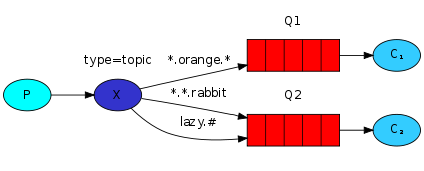Topics模式,官方的解释是Receiving messages based on a pattern (topics),它的结构是

消费者各自监控自己的队列;交换机通过一种模式策略确定生产者的消息放入那个队列。
配置文件。增加类TopicRabbitConfig,编制代码为
- package com.example;
-
- import org.springframework.amqp.core.Binding;
- import org.springframework.amqp.core.BindingBuilder;
- import org.springframework.amqp.core.Queue;
- import org.springframework.amqp.core.TopicExchange;
- import org.springframework.context.annotation.Bean;
- import org.springframework.context.annotation.Configuration;
-
- @Configuration
- public class TopicRabbitConfig {
-
- final static String message = "topic.message";
- final static String messages = "topic.messages";
-
- @Bean
- public Queue queueMessage() {
- return new Queue(TopicRabbitConfig.message);
- }
-
- @Bean
- public Queue queueMessages() {
- return new Queue(TopicRabbitConfig.messages);
- }
-
- @Bean
- TopicExchange exchange() {
- return new TopicExchange("exchange");
- }
-
- @Bean
- Binding bindingExchangeMessage(Queue queueMessage, TopicExchange exchange) {
- return BindingBuilder.bind(queueMessage).to(exchange).with("topic.message");
- }
-
- @Bean
- Binding bindingExchangeMessages(Queue queueMessages, TopicExchange exchange) {
- return BindingBuilder.bind(queueMessages).to(exchange).with("topic.#");
- }
- }
7、消息发送。增加类TopicSender,编制代码为
- package com.example;
-
- import org.slf4j.Logger;
- import org.slf4j.LoggerFactory;
- import org.springframework.amqp.core.AmqpTemplate;
- import org.springframework.beans.factory.annotation.Autowired;
- import org.springframework.stereotype.Component;
-
- @Component
- public class TopicSender {
-
-
- protected static Logger logger=LoggerFactory.getLogger(TopicSender.class);
-
- @Autowired
- private AmqpTemplate rabbitTemplate;
- public void send1() {
- String context = "hi, i am message 1";
- logger.debug("Sender : " + context);
- this.rabbitTemplate.convertAndSend("exchange", "topic.message", context);
- }
-
- public void send2() {
- String context = "hi, i am messages 2";
- logger.debug("Sender : " + context);
- this.rabbitTemplate.convertAndSend("exchange", "topic.messages", context);
- }
- }
8、消息接收1.增加类TopicReceiver,编制代码为
- package com.example;
-
- import org.slf4j.Logger;
- import org.slf4j.LoggerFactory;
- import org.springframework.amqp.rabbit.annotation.RabbitHandler;
- import org.springframework.amqp.rabbit.annotation.RabbitListener;
- import org.springframework.stereotype.Component;
-
- @Component
- @RabbitListener(queues = "topic.message")
- public class TopicReceiver {
-
- protected static Logger logger=LoggerFactory.getLogger(TopicReceiver.class);
-
- @RabbitHandler
- public void process(String message) {
- logger.debug("Topic Receiver1 : " + message);
- }
-
- }
9、消息接收2.增加类TopicReceiver2,编制代码为
- package com.example;
-
- import org.slf4j.Logger;
- import org.slf4j.LoggerFactory;
- import org.springframework.amqp.rabbit.annotation.RabbitHandler;
- import org.springframework.amqp.rabbit.annotation.RabbitListener;
- import org.springframework.stereotype.Component;
-
- @Component
- @RabbitListener(queues = "topic.messages")
- public class TopicReceiver2 {
-
- protected static Logger logger=LoggerFactory.getLogger(TopicReceiver2.class);
-
-
- @RabbitHandler
- public void process(String message) {
- logger.debug("Topic Receiver2 : " + message);
- }
-
- }
10、RestController。增加类TopicController,编制代码为
- package com.example;
-
- import org.springframework.beans.factory.annotation.Autowired;
- import org.springframework.web.bind.annotation.RequestMapping;
- import org.springframework.web.bind.annotation.RestController;
-
- @RestController
- public class TopicController {
-
- @Autowired
- private TopicSender topicSender;
-
- @RequestMapping("/send1")
- public String send1() {
- topicSender.send1();
- return "send1 ok";
- }
-
- @RequestMapping("/send2")
- public String send2() {
- topicSender.send2();
- return "send2 ok";
- }
- }
11、运行工程。在工程所在文件夹打开cmd,输入mvn spring-boot:run
12、在浏览器中分别输入http://localhost:9080/send1 ,http://localhost:9080/send2,查看控制台输出
http://localhost:9080/send1,控制台的输出,两个接收器都收到消息
http://localhost:9080/send2,控制台的输出,第二个接收器收到消息
13、小结
A、在配置文件中,定义了一个TopicExchange,然后对两个队列,分别配置了绑定规则。(变更绑定规则测试时,先停止命令行的spring-boot,再删除rabbitmq management中的队列)。
B、发送器,发送send1会匹配到topic.#和topic.message 两个Receiver都可以收到消息,发送send2只有topic.#可以匹配所有只有Receiver2监听到消息。
发送器在发送消息时,使用的方法是需要传入一个特定的交换机的。
C、接收器,依然各自监控自己的队列;

























 1466
1466

 被折叠的 条评论
为什么被折叠?
被折叠的 条评论
为什么被折叠?








